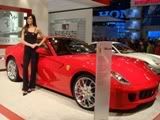Benefits of the hybrid electric design include:
- Fuel consumption
- Current HEVs reduce petroleum consumption (compared to otherwise similar conventional vehicles) primarily by using three mechanisms:
a) Reducing wasted energy during idle/low output, generally by turning the ICE off;
b) Recapturing waste energy (i.e. regenerative braking);
c) Reducing the size and power of the ICE engine, and hence inefficiencies from under-utilization, by using the added power from the electric motor to compensate for the loss in peak power output from the smaller ICE.
Any combination of these three primary hybrid advantages may be used in different vehicles to realize different fuel usage, power, emissions, weight and cost profiles. The ICE in an HEV can be smaller, lighter, and more efficient than the one in a conventional vehicle, because the combustion engine can be sized for slightly above average power demand rather than peak power demand. The drive system in a vehicle is required to operate over a range of speed and power, but an ICE has its highest efficiency is in a narrow range of operation, making conventional vehicles inefficient. In contrast, in most HEV designs, the ICE operates closer to its range of highest efficiency more of the time. The power curve of electric motors is better suited to variable speeds and can provide substantially greater torque at low speeds compared with internal-combustion engines. The greater fuel economy of HEVs has implication for reduced petroleum consumption and vehicle air pollution emissions worldwide - Durability
- Reduced wear on the gasoline engine, particularly from idling with no load. Reduced wear on brakes from the regenerative braking system use.
- There's no definitive word on replacement costs of the batteries because they are almost never replaced. According to Toyota, since the Prius first went on sale in 2000, they have not replaced a single battery for wear and tear. (2007)
- Environmental impact
- Reduced noise emissions resulting from substantial use of the electric motor at idling and low speeds, leading to roadway noise reduction, in comparison to conventional gasoline or diesel powered engine vehicles, resulting in beneficial noise health effects (although road noise from tires and wind, the loudest noises at highway speeds from the interior of most vehicles, are not affected by the hybrid design alone). Note, however, that this is not always an advantage; for example, people who are blind or visually-impaired, and who rely on vehicle-noise while crossing streets, find it more difficult to do safely. Reduced air pollution emissions due to lower fuel consumption, leading to improved human health with regard to respiratory and other illness. Pollution reduction in urban environments may be particularly significant due to elimination of idle-at-rest.
- One common misconception is: "However, one must remember the environmental stamp of HEV batteries, which must be replaced on a regular basis and are treated as extremely hazardous waste." This is not entirely true. Battery toxicity is a concern, although today's hybrids use NiMH batteries, not the environmentally problematic rechargeable nickel cadmium. "Nickel metal hydride batteries are benign. They can be fully recycled," says Ron Cogan, editor of the Green Car Journal. Toyota and Honda say that they will recycle dead batteries and that disposal will pose no toxic hazards. Toyota puts a phone number on each battery, and they pay a $200 "bounty" for each battery to help ensure that it will be properly recycled.
- There's no definitive word on replacement costs of the batteries because they are almost never replaced. According to Toyota, since the Prius first went on sale in 2000, they have not replaced a single battery for wear and tear.









